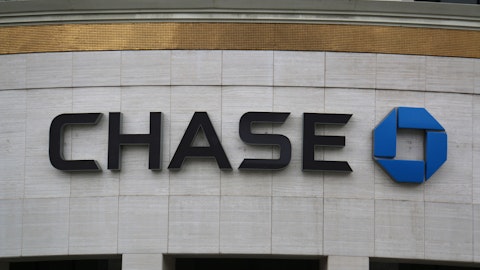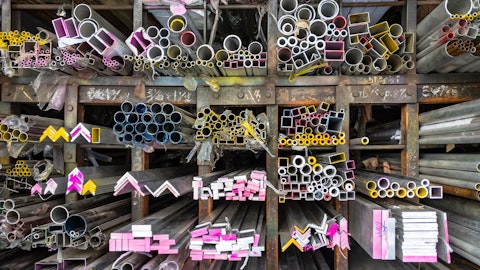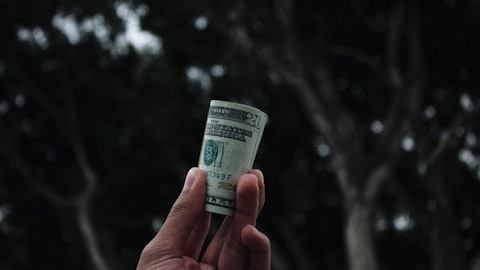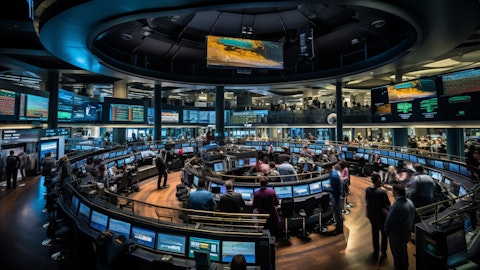Jim Fitterling: Yes. On project starts, we’ve got the things that we’ve got coming up, obviously, is we’ve got some alkoxylation capacity that came up in ’22 and ’23, it’s running really well. We started up the MDI distillation facility in Freeport in the third quarter. I think that will start to show some positive benefit to us as we move forward. That’s about a 30% increase in MDI distillation, and also reduction of a footprint getting us out of the La Porte site. We’ve got CDF alkoxylation, second wave expansion in fourth quarter of this year, and then Terneuzen in fourth quarter of 2025, both of that supports growing demand and energy and also consumer solutions and pharma business, so that’s good. Amines business for carbon capture is growing well, and so that’s good.
If you look at plastics industry, there’s really no new capacity coming out in plastics say one train at the Shell plant in the United States. Otherwise, all the plastics capacity is in the market, inventories are low, export channels running strong, and we saw volume growth year-over-year in the fourth quarter. So, I feel good about the overall outlook for plastics as we’re going into 2024. When you get into polyolefins, our polyurethanes and propylene oxide, a little bit different story. That capacity come on in China. We’ve seen the same in siloxanes last year. I think we’re working through that. The silicones growth is going to eat up that siloxane capacity, but we’ve got to see the durable goods market and the housing markets come back to tighten up PO.
Propylene Glycol side has been strong. But as you know housing and automotive drives PPE a lot. Those two things drive the propylene markets and we’re going to keep a close eye on them.
Operator: Your next question…
Jim Fitterling: Jeff, do you want to cover pension and what we did?
Jeff Tate: Sure, Jim. As we’ve been communicating to the Street here in recent quarters, one of the things that we’re consistently looking to do as we’re solidifying our financial position is look for ways to derisk our pension plans. And one of those could be around annuitization as well as risk transfer of our liabilities. So specifically in fourth quarter, we were actually able to reduce our pension liabilities by $1.7 billion. The execution of those transactions did not require any additional cash from the company. As Jim mentioned in some of his opening remarks, the impact of that was a one-time non-cash non-operating settlement charge of $640 million in the quarter.
Operator: Your next question comes from the line of Jeff Zekauskas from JPMorgan. Your line is open.
Jeff Zekauskas: Thanks very much. Recently, there was a cold snap in Texas. And I didn’t notice that there was any penalty in EBITDA for the first quarter. Are you still assessing what the amounts might be, or do you think that it’s zero? And then, secondly, you pulled out $1 billion in costs. Can you allocate the $1 billion across your three segments?
Jim Fitterling: Sure. I’ll take the cold snap, and then, Jeff, I’ll have you take a look at the costs. Look, on the freeze, Jeff, I just want to go back, two years ago, this is the third consecutive year of freeze on the Gulf Coast. And we’ve improved plans every year to be able to be ready for that. This year will be the lowest impact we’ve had of any of the three years. And so, the big impacts that hit us were at Deer Park and at Seadrift, but almost all of that is back up and running now. So, we were able to rebound pretty quickly. You never go completely unscathed, but I think we managed through it pretty well. We haven’t had to disrupt any customers because of downtime. And I think we’re going to recover pretty strong here and be running hard by the end of this month.
So, I feel that we’ve navigated it pretty well. And we didn’t see enough of an impact that we put that into first quarter estimates. I think our biggest delta in first quarter is we’ve got quite a few turnarounds in the first quarter, and so that’s our biggest impact about $200 million of turnarounds in the quarter — $150 million. And then, we expect some margin and some seasonality in first quarter, say, plus $200 million on margins and minus $150 million on turnarounds in the quarter. So that’s the biggest net-net on the first quarter ’24 guidance. Jeff, do you want to hit how the $1 billion costs fell across the business?
Jeff Tate: Absolutely, Jim. In the simplest terms, about 50% of those cost savings are in P&FP, 20% to 25% are in the other two segments, respectively, and we also have a little bit in corporate as well. So, pretty well distributed based on our operations and our revenues as well.
Jim Fitterling: We ended the year at a $1.4 billion run rate on that. So, if you look at full year 2024, Jeff, we still got another $400 million coming in in terms of the cost savings for ’24, but we have $200 million of higher turnarounds in 2024, so net-net $200 million coming into 2024. I hope that covers what you’re looking for.
Operator: Your next question comes from the line of Steve Byrne from Bank of America. Your line is open.
Steve Byrne: Yes. Thank you. I’d like to get some help from you on why were the earnings in PM&C so much lower than what you were expecting, say, in the third quarter slide deck. Would you attribute this to just lower pricing, higher raws? Help me on this one. And maybe in particular, coatings, you’ve got a key customer raising price and targeting mid-single digit lower raws. Your propylene costs are higher. Why not able to push more price in this segment, or cut back on operating rates or something along those lines? What’s your outlook for that segment?





